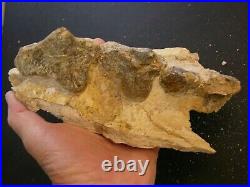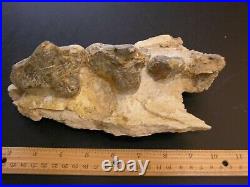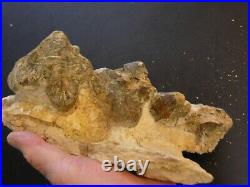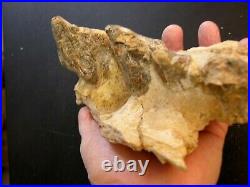Dinosaur jaw bone with teeth Basilosaurus fossil Eocene 8.5x4x3.5 ba5












These fossil teeth are in the jaw bone and the visible part of the teeth measures about 8 inches and were most likely the lower jaw molars. Basilosaurus is one of the largest-known, 49-66 feet long, animals to exist from the extinction event 66 million years ago, to around 15 million years ago when modern cetaceans began to reach enormous sizes. Basilosaurus is considered to be the largest of archeocete whales.
The cheek teeth of Basilosaurus retain a complex morphology and functional occlusion. Heavy wear on the teeth reveals that food was first chewed then swallowed.Scientists were able to estimate the bite force of Basilosaurus by analyzing the scarred skull bones of another species of prehistoric whale, Dorudon, and concluded they could bite with a force of 3,600 pounds per square inch. Analyses of the stomach contents has shown that this species fed exclusively on fish and large sharks, It was probably an active predator rather than a scavenger. Basilosaurus, "king lizard", is a genus of large, predatory, prehistoric archaeocete whale from the late Eocene, approximately 41.3 to 33.9 million years ago. First described in 1834, it was the first archaeocete and prehistoric whale known to science. The first fossils were discovered along the Gulf Coast of the United States, in 1904 in North Africa, more specifically the countries of Egypt, Jordan, Tunisia and Morocco.
One of the largest if not the largest, animals of the Paleogene. It was the top predator of its environment, preying on sharks, large fish and other marine mammals, namely the dolphin-like Dorudon, which seems to have been their predominant food source. Basilosaurus, unlike modern cetaceans, had various types of teeth-such as canines and molars-in its mouth and it probably was able to chew its food in contrast to modern cetaceans which swallow their food whole.